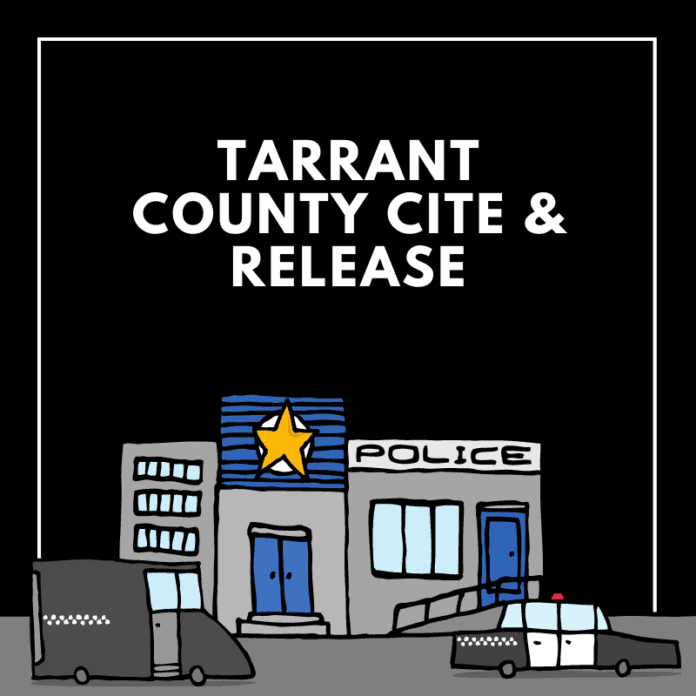(Tarrant County, TX) – A person detained by the police for certain low-level, misdemeanor crimes in Tarrant County may now be issued a citation, instead of being immediately arrested.
The change is part of a law called Cite and Release that was passed by the Texas Legislature in 2007. Under the law, a defendant charged with some Class A and B misdemeanor offenses is eligible for a citation, rather than an immediate arrest. Tarrant County Law Enforcement Executives, Tarrant County magistrates and the Criminal District Attorney’s Office worked together in recent months to determine how it will be implemented.
“The search for improvement in the criminal justice system is a continual process. Police, prosecutors and courts always seek to improve the fairness, accuracy and speed of the system which benefits all stakeholders, including the accused,” Azle Police Chief Rick Pippins said.
Here’s how it works: Officers issue a citation to appear before Tarrant County magistrates on a certain date, instead of making an immediate arrest. When the offender appears, the magistrate notifies the law enforcement agency that wrote the citation. The law enforcement agency then files the case with the DA’s Office for prosecution.
Not Every Agency In Tarrant County May Choose to Use Cite and Release
“Offenders who receive a citation will still have their cases filed with the DA’s office. Tarrant County has 41 municipal law enforcement agencies. Not every agency may choose to use Cite and Release,” said Chief Cody Phillips, City o fHaltom City Police Department and president of the Tarrant County Law Enforcement Executives Association.
“A custodial arrest is not always the best course of action when trying to balance the best way to handle criminal behavior. Cite and Release gives the officer another tool at their discretion to address situations where a crime has been committed but making an arrest is not in the best interest of justice,” said Dalworthington Gardens Police Chief Greg Petty.
Eligible charges include: Possession of marijuana less than two ounces; possession of marijuana between two and four ounces; possession of controlled substance in penalty group 2A less than two ounces; possession of controlled substance in penalty group 2A between two and four ounces; criminal mischief if the amount of loss is between $100 and $750; graffiti if the amount of loss is between $100 and $2,500; and theft if the value stolen is between $100 and $750.
“We are not dismissing theft or drug cases,” Tarrant County Criminal District Attorney Sharen Wilson said. “This is just another way to prosecute these cases efficiently.”
Requirements To Be Eligible For Cite & Release vs. Arrest
To be eligible for a citation instead of an immediate arrest, the offender must be an adult who lives in Tarrant County and committed the offense in Tarrant County as well. The offender must have ID sufficient to prove his or her identity. The offender must not have an outstanding warrant for a Class B or higher offense.
Other Texas counties such as Harris, Dallas, Bexar and Travis already have begun to use Cite and Release.
“Cite and Release may provide an avenue for officers to focus on more critical calls for service,” Sansom Park Police Chief
Carolyn Gilmore said.
“The benefits of Cite and Release are that it can save officers time, jail costs and taxpayer dollars, while using the existing magistrate and prosecution systems. It is a win-win for all involved,” Everman Police Chief Craig Spencer said.
“We believe it will be a great opportunity to lessen the burdens on both the citizen and officer,” said Fort Worth Assistant Police Chief Joseph Sparrow.
“We will support this program by giving officers an additional option to cite and release a person who meets the criteria,” said Arlington Police Chief Alexander Jones. “Officers will also still have discretion on whether to arrest the person and bring them to jail or field release them through this new program for certain qualifying misdemeanors.”











